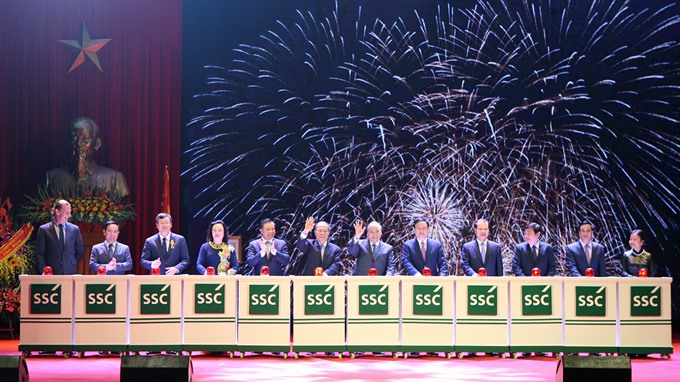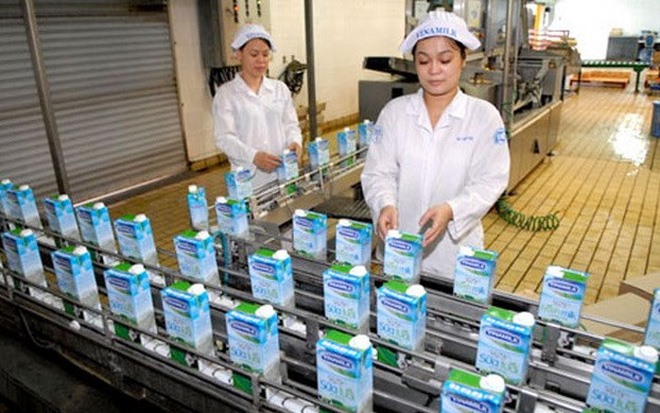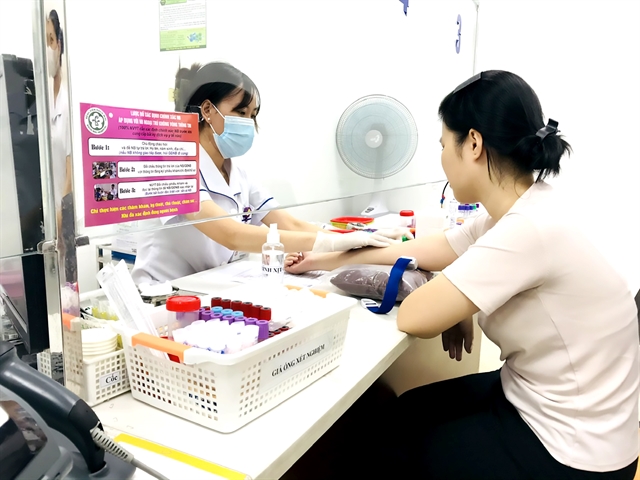 Economy
Economy

Việt Nam’s stock market has kept its nose ahead in 2016 despite several negative impacts of international events. The 10 biggest events on the securities market in 2016 were announced yesterday.
 |
| The State Securities Commission on November 28 received the Independence Order, Second Class from the Government, marking the 20th anniversary of the securities sector. — VNA/VNS Photo Tuấn Anh |
HÀ NỘI — Việt Nam’s stock market has kept its nose ahead in 2016 despite several negative impacts of international events. The 10 biggest events on the securities market in 2016 were announced yesterday.
1. Securities sector turns 20
The State Securities Commission on November 28 received the Independence Order, Second Class as it marked the securities’ sector’s 20th anniversary.
For the past 20 years, Việt Nam has developed a securities market that functions well, with more than 1,000 public companies listed on the two exchanges in HCM City and Hà Nội.
The market capitalisation of all listed companies has reached US$70 billion, attracting 1.6 million domestic and international investors. The State has also raised more than VNĐ2 quadrillion ($88.9 billion) for national development, and more than 4,000 enterprises have been equitised on the Việt Nam’s stock market.
2. Year of international shocks
Việt Nam’s stock market experienced significant impacts of several international events, including the shutdown of China’s stock market on April 1, the Brexit vote on June 24 and the US presidential election on November 9.
All these events shook the Vietnamese stock market, leading to sell-offs by investors. Two of the worst hits were on June 24 and November 11 when the benchmark VN Index slumped 5.5 per cent and 3 per cent, respectively.
3. Circular directs trading of SOE shares
Circular 115/2016/TT-BTC took effect on November 1. It says that a State-owned enterprise (SOE) must trade its shares on the Unlisted Public Company Market (UPCoM) within 20 days of its IPO (initial public offering).
Previously, under Decision 51/2014/QĐ-TTg, shares of an equitised SOE needed to be traded within 90 days of the IPO.
4. VNX Allshare Index launched
The VNX Allshare Index, the common index for all stocks on the two local exchanges, was launched on October 24.
This move is expected to help increase market capitalisation and upgrde the Vietnamese stock market from a frontier market to an emerging market.
The launching of the VNX Allshare Index has been welcomed by domestic and international investors. The merger of the two local stock exchanges is awaiting the Government’s official approval.
 |
| A Vinamilk packaging line. The sale of State holdings in the dairy giant was the biggest deal in Southeast Asia this year. - VNA/VNS Photo Hồng Phúc |
5. Holdings in largest SOEs sold
On December 12, the State Capital Investment Corporation (SCIC), on behalf of the Government, sold 9 per cent of its ownership in the Việt Nam Dairy Products Joint Stock Company (Vinamilk) at an auction on the HCM Stock Exchange.
More than 78.3 million shares of Vinamilk, equal to 60 per cent of the shares offered at the auction, were offloaded to two foreign investors, F&N Dairy Investment Pte Ltd and F&N Bev Manufacuring PTE LTD. The deal reduced the State’s ownership in Vinamilk to 3.6 per cent.
SCIC sold those shares at the price of VNĐ144,000 per share, raising VNĐ11.28 trillion for the State. The deal was the biggest in Southeast Asia and one of the remarkable deals struck in 2016.
After the Vinamilk deal, the SCIC is also expected to divest from 10 largest corporations next year.
6. Faros Construction Corporation
In 2016, the Faros Construction Corporation drew the attention of local and international media, investors and analysts as it increased its chartered capital by 2,860 times to VNĐ4.3 trillion from the original VNĐ1.5 billion in 2011.
The company’s shares, which are listed on the HCM Stock Exchange as ROS, advanced the most in 2016. It soared 15 times from the debut price of VNĐ8,400 on September 1 to VNĐ127,000 on November 28, making the company one of the 10 largest listed firms by market capitalisation.
7. MTM and the risk of company’s information transparency
31 million shares of the Central Mining and Mineral Import-Export JSC, traded on UPCoM as MTM, were suspended from trading on June 20 by the Hà Nội Stock Exchange to protect investors’ benefits and interests.
On the date of suspension, MTM price was VNĐ2,600 –one-fifth of its starting price on UPCoM.
In September, the Ministry of Public Security arrested Trần Hữu Tiệp, chairman of Central Mining and Mineral Import - Export JSC, for business frauds in Hà Nội and other provinces.
The case of MTM alarmed investors, securities companies and market regulators about a new kind of risk - a “zombie company” with no assets or operations being traded on the securities market.
After that case, investors, traders and regulators are expected to improve their management and supervision of the UPCoM, given its significant development in recent times. On December 16, 394 companies registered to trade on UPCoM. The rising number of companies trading on UPCoM is expected to increase market capitalisation to nearly $13 billion, twice that of the Hà Nội Stock Exchange.
8. Derivatives market in 2017
The Hà Nội Stock Exchange and the Vietnam Securities Depository on March 16 announced the model and plan to develop the settlement and trading system for derivatives market. By the end of 2016, the two agencies and market members would have basically completed preparations and derivatives products can be launched in 2017.
The derivatives market is expected to complete the structure of t Việt Nam’s stock market, diversify its financial products, offer more options to investors and meet demand for high-quality financial products.
9. Productive year for Government bonds
The Government bond market developed significantly this year. The Government raised VNĐ281 trillion from the issuance of primary bonds. Based on increasing market demand, the Government had to change its whole-year issuance target twice from the original VNĐ220 trillion. This is also the first year that the Government accomplished its issuance plan in September with VNĐ250 trillion worth of primary bonds raised from the stock market.
Twenty and 30-year term bonds also became more attractive to investors. By the year end, the average term for Government bonds is set to be 8.27 years. Based on this fact and lower deposit rates, the Government will be able to use funds raised from long-term bonds to reduce the pressure on short-term debt.
The Government also raised VNĐ1.5 quadrillion from the secondary bond market this year with an average trading value of VNĐ6.2 trillion in each session, the highest values ever.
10. Raising foreign ownership in local companies
The decision to lifting limits on foreign ownership in Vietnamese public companies was the hottest topic this year on the stock market. However, after the Government issued Decree 60/2015/NĐ-CP in June 2015, very few local companies have completely raised the bar for foreign investors.
Investors, traders and regulators have been wondering whether the Government can resolve issues relating to this decision, given that the new Law on Investment is in force and the Law of Securities Market won’t be proposed to the National Assembly until 2018.
In fact, listed companies must carefully review the decision and other items written in the Law of Investment as foreign investors are now legible to purchase up to 49 per cent of the firm’s capital but they have to seek approval from the market regulators to increase the room for more foreign capital.
The legal status of a local company will be re-labeled as a foreign-invested company if foreign shareholders own more than 49 per cent of the company’s capital. The company then will have to follow the rules set for foreign-owned companies, including taxation, investment and lending, which could disadvantage them in the local market. — VNS




